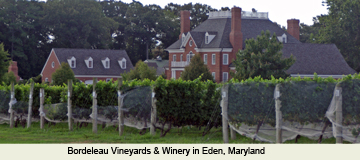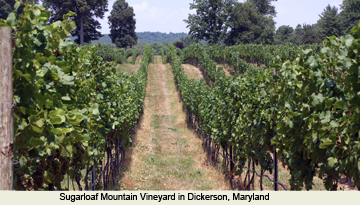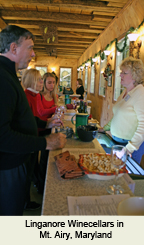Some Misconceptions about Maryland Wineries
by
Terry Sullivan
I wrote about some of the misconceptions about Maryland wine, now it is time to turn to some misconceptions about Maryland wineries. Most of these misconceptions are not unique to Maryland. Many states and wine regions throughout the world that are relatively new face the same misconceptions.
Misconception #1: Maryland has wineries?
 Many wineries in most states have complained that the local community doesn’t know they have a winery in their own backyard. Lois Loew of Loew’s Vineyard in Mt. Airy, Maryland has visitors who comment that they didn’t know Maryland had wineries. Carl O. DiManno winemaker and vineyard manager at Sugarloaf Mountain Vineyard in Dickerson, Maryland seconds that sentiment.
Many wineries in most states have complained that the local community doesn’t know they have a winery in their own backyard. Lois Loew of Loew’s Vineyard in Mt. Airy, Maryland has visitors who comment that they didn’t know Maryland had wineries. Carl O. DiManno winemaker and vineyard manager at Sugarloaf Mountain Vineyard in Dickerson, Maryland seconds that sentiment.
People often associate wineries with wine regions. If there is just one winery in an area, some of the local community will come to visit. If there are two wineries next to each other, people from surrounding communities will come to visit. If several wineries are close by and form a region, people from further away will come to visit because they can taste several wines from several wineries. The Marylandwine.com websites lists 53 wineries that are spread throughout the state. This presents a challenge to draw visitors to their tasting rooms. Wine Trail Traveler has visited and written about 40 of those wineries.
There are new Maryland Wineries opening to the public each year.
Misconception #2: Maryland wineries source all their wine grapes from the west coast.
Caught! I am guilty of this. This is the second year that I am making wine at Tin Lizzie Wineworks in Howard County, Maryland. Each year I sourced grapes from Stagecoach Vineyards in the Atlas Peak AVA in Napa Valley. I do like Napa Cabs and wanted to craft a Napa Cab. At the same time, I am also crafting a white Cabernet Sauvignon. I sourced the juice from Thanksgiving Farm Wines in Harwood, Maryland. A couple years ago Kathy made a peach wine with peaches sourced from Howard County. We also made a sparkling Niagara wine with grapes sourced from our backyard. Not all of the wine we make is crafted with grapes from the west coast.
 Although some Maryland wineries source fruit from California, Oregon and Washington, this concept is over generalized. Many Maryland wines are made from fruit grown in Maryland. Morris Zwick of Terrapin Station Winery in Elkton, Maryland believes the key is for consumers to read the labels on the wine bottles. If the bottle states a particular region such as Napa, the fruit was sourced from that region. If the word American appears on the bottle the fruit was also sourced from out of the state. If the bottle says Maryland on the label, the vast majority of the fruit used to make the wine is from Maryland.
Although some Maryland wineries source fruit from California, Oregon and Washington, this concept is over generalized. Many Maryland wines are made from fruit grown in Maryland. Morris Zwick of Terrapin Station Winery in Elkton, Maryland believes the key is for consumers to read the labels on the wine bottles. If the bottle states a particular region such as Napa, the fruit was sourced from that region. If the word American appears on the bottle the fruit was also sourced from out of the state. If the bottle says Maryland on the label, the vast majority of the fruit used to make the wine is from Maryland.
Many wineries throughout the country source fruit from the west coast and New York State. Often this is to acquire fruit that doesn’t grow in their state. Zwick pointed out, “there is an undersupply of grapes in Maryland. However, the state and many of the counties are aggressively promoting grape planting, so we hope to see the supply situation improve over the next decade.”
Sarah O'Herron of Black Ankle Vineyards in Mt. Airy, Maryland commented that many people believe that it is impossible to grow good vinifera grapes in the state. However, wine tasters who want to experience terroir at a Maryland winery should taste wines with the word Maryland on the label. They should also ask about the location of the vineyards. Not all Maryland wineries, nor wineries in other states, have their own vineyards.
Data from Marylandgrapes.org shows that as of 2010 there were 637 acres of vineyards representing 150 vineyards across the state. Of those acres, 405 acres were at Maryland wineries. Data from 2012 has not been released as of this writing, but is expected to show increased acreage.
 Misconception #3: Maryland wineries are small cottage-like facilities.
Misconception #3: Maryland wineries are small cottage-like facilities.
Travel to Maryland wineries. Some are small cottage-like facilities while others are quite large facilities. At Cove Point Winery in Lusby, Maryland we tasted wines at a kitchen counter. We also had kitchen tasting experiences in Napa. The tasting room at Orchid Cellar Winery in Middletown was in the lower level of a house. Maryland also has the garagistes wineries. These smaller wine tasting rooms, garagistes and kitchens offer an intimate tasting experience.
There are many larger tasting rooms and wineries throughout the state. Linganore Winecellars in Mt. Airy is a larger facility that can accommodate bus loads of wine enthusiasts. Bordeleau Vineyards and Winery in Eden has a large tasting room and property. It is also one of the few Maryland wineries that one can visit by boat.
A positive about Maryland wineries is that they do come in all sizes. Get out and visit the Maryland wineries and experience the wine experience.
Article written April 2013.
You may also like to read Misconceptions about Maryland wine article.
